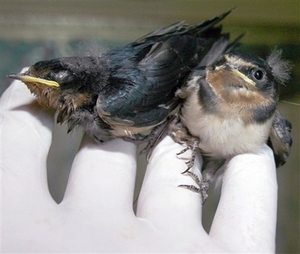
|
| ©AP Photo/Daily Citizen, Samuel Peebles |
| Two baby conjoined barn swallows rest after a fall from their nest Thursday morning, July 17, 2008 in Searcy, Arkansas. |
"I can't even say it's one in a million - it's probably more than that," said Karen Rowe, an ornithologist with the Arkansas Game & Fish Commission. "There's just very little to no records of such a thing."
The birds, found by a landowner in White County earlier this week, fell out of a nest as a healthy sibling flew off to learn how to hunt with its parents, Rowe said. The birds first appeared to have only three legs, but further examination found a fourth leg tucked up underneath the skin connecting the pair.
Rowe said the landowner likely kept the birds for a day before calling wildlife officials. By the time officials arrived, the two birds refused to eat. One of the birds died early Friday morning and a veterinarian later euthanized the other.
While conjoined twins have been documented in humans, other mammals and reptiles, finding conjoined birds is difficult, as they likely die before being discovered, Rowe said. X-rays of the pair found each bird was fully formed, Rowe said. Scientists at the Smithsonian will examine the birds to determine whether they were fraternal twins or identical twins.
Rowe said the birds would have had to come from a double-yolk egg.
Barn swallows hunt insects in flight and make mud nests. The typical bird can live for several years, though the conjoined twins might not have lived that long even if they had been successfully separated. Rowe said it would have been difficult to teach the birds to fly.
"It's just amazing to think they were attached and had two brains," Rowe said.



Reader Comments
to our Newsletter